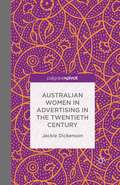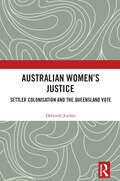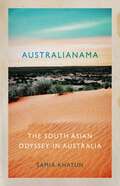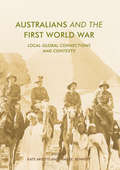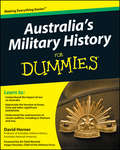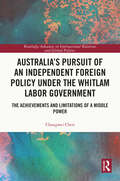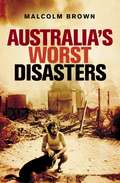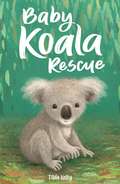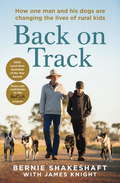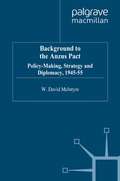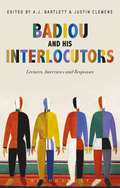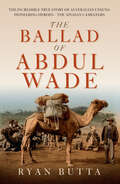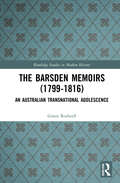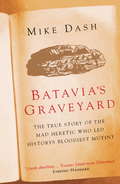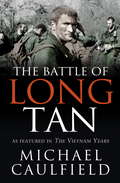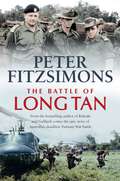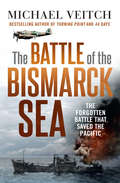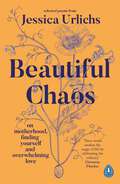- Table View
- List View
Australian Women in Advertising in the Twentieth Century
by J. DickensonWhen did Australian women first enter the advertising industry? The stereotypical advertising executive might be a pony-tailed, Ferrari-driving, young-ish man, but women have worked in Australian advertising agencies from the first years of the modern industry, and today they comprise half of the industry's workforce. Australian Women in Advertising in the Twentieth Century rescues these women from their obscurity. By employing a broader definition of advertising than usual, this study reveals the important role women have played in the development of the Australian advertising industry, sheds light on women's struggle to reach the higher echelons of the industry, and considers why the popular image of the advertising executive is at such variance from the reality. The experiences of these remarkable women across a century of Australian advertising provide valuable information on the role of gender in the development of this ubiquitous industry, as well as the encroachment of consumer culture.
Australian Women's Justice: Settler Colonisation and the Queensland Vote
by Deborah JordanThis book explores how women spearheaded the democratic suffrage campaign in colonial Queensland engaging with international debates on women’s activism, leadership, advocacy, print culture, and social movements. Australian Women's Justice provides a nuanced reading of the diversity and differences of the women’s movement in Queensland, from the time of first white colonisation, federation to World War 1 by new research on key women’s organisations: notably the Women’s Equal Franchise Association and the Women’s Peace Army. Framed through the lives of women suffrage participants, including their encounters with First Nations women, it also looks beyond microhistory to explore broader themes of the intersection of race, gender, property, war, and empire in the colonial context. Campaigns for enfranchisement and property rights and against conscription connect this story with larger international movements for women and labour, and organisations such as the League of Nations. This book will be of interest to students and researchers of Australian feminism and suffragism, as well as historians of feminist, labour, and peace movements both in Australia and internationally.
Australian Women's Justice: Settler Colonisation and the Queensland Vote
by Deborah JordanThis book explores how women spearheaded the democratic suffrage campaign in colonial Queensland engaging with international debates on women’s activism, leadership, advocacy, print culture, and social movements. Australian Women's Justice provides a nuanced reading of the diversity and differences of the women’s movement in Queensland, from the time of first white colonisation, federation to World War 1 by new research on key women’s organisations: notably the Women’s Equal Franchise Association and the Women’s Peace Army. Framed through the lives of women suffrage participants, including their encounters with First Nations women, it also looks beyond microhistory to explore broader themes of the intersection of race, gender, property, war, and empire in the colonial context. Campaigns for enfranchisement and property rights and against conscription connect this story with larger international movements for women and labour, and organisations such as the League of Nations. This book will be of interest to students and researchers of Australian feminism and suffragism, as well as historians of feminist, labour, and peace movements both in Australia and internationally.
Australianama: The South Asian Odyssey in Australia
by Samia KhatunAustralian deserts remain dotted with the ruins of old mosques. Beginning with a Bengali poetry collection discovered in a nineteenth-century mosque in the town of Broken Hill, Samia Khatun weaves together the stories of various peoples colonized by the British Empire to chart a history of South Asian diaspora. Australia has long been an outpost of Anglo empires in the Indian Ocean world, today the site of military infrastructure central to the surveillance of 'Muslim-majority' countries across the region. Imperial knowledges from Australian territories contribute significantly to the Islamic-Western binary of the post- Cold War era. In narrating a history of Indian Ocean connections from the perspectives of those colonized by the British, Khatun highlights alternative contexts against which to consider accounts of non-white people. Australianama challenges a central idea that powerfully shapes history books across the Anglophone world: the colonial myth that European knowledge traditions are superior to the epistemologies of the colonized. Arguing that Aboriginal and South Asian language sources are keys to the vast, complex libraries that belie colonized geographies, Khatun shows that stories in colonized tongues can transform the very ground from which we view past, present and future.
Australianama: The South Asian Odyssey in Australia
by Samia KhatunAustralian deserts remain dotted with the ruins of old mosques. Beginning with a Bengali poetry collection discovered in a nineteenth-century mosque in the town of Broken Hill, Samia Khatun weaves together the stories of various peoples colonized by the British Empire to chart a history of South Asian diaspora. Australia has long been an outpost of Anglo empires in the Indian Ocean world, today the site of military infrastructure central to the surveillance of 'Muslim-majority' countries across the region. Imperial knowledges from Australian territories contribute significantly to the Islamic-Western binary of the post- Cold War era. In narrating a history of Indian Ocean connections from the perspectives of those colonized by the British, Khatun highlights alternative contexts against which to consider accounts of non-white people. Australianama challenges a central idea that powerfully shapes history books across the Anglophone world: the colonial myth that European knowledge traditions are superior to the epistemologies of the colonized. Arguing that Aboriginal and South Asian language sources are keys to the vast, complex libraries that belie colonized geographies, Khatun shows that stories in colonized tongues can transform the very ground from which we view past, present and future.
Australians and the First World War: Local-Global Connections and Contexts
by Kate Ariotti James E. BennettThis book contributes to the global turn in First World War studies by exploring Australians’ engagements with the conflict across varied boundaries and by situating Australian voices and perspectives within broader, more complex contexts. This diverse and multifaceted collection includes chapters on the composition and contribution of the Australian Imperial Force, the experiences of prisoners of war, nurses and Red Cross workers, the resonances of overseas events for Australians at home, and the cultural legacies of the war through remembrance and representation. The local-global framework provides a fresh lens through which to view Australian connections with the Great War, demonstrating that there is still much to be said about this cataclysmic event in modern history.
Australians and the First World War: Local-Global Connections and Contexts
by Kate Ariotti James E. BennettThis book contributes to the global turn in First World War studies by exploring Australians’ engagements with the conflict across varied boundaries and by situating Australian voices and perspectives within broader, more complex contexts. This diverse and multifaceted collection includes chapters on the composition and contribution of the Australian Imperial Force, the experiences of prisoners of war, nurses and Red Cross workers, the resonances of overseas events for Australians at home, and the cultural legacies of the war through remembrance and representation. The local-global framework provides a fresh lens through which to view Australian connections with the Great War, demonstrating that there is still much to be said about this cataclysmic event in modern history.
Australia's Military History For Dummies
by David HornerCreated especially for the Australian customer! The simple and easy way to get your mind around Australia's military history More people are visiting Gallipoli and walking the Kokoda Trail each year — now find out why. This complete guide helps you trace the story of Australia's involvement in war, from the colonial conflicts with the Indigenous population, through the World Wars to peacekeeping initiatives in East Timor and the controversial conflict in Afghanistan. Find out the origins of Australia's military history — go all the way back to the arrival of the First Fleet and the conflicts with the Indigenous peoples Learn about the heroism of the Anzacs — discover the origins of the legend of Gallipoli, and how the brass bungled the campaign Discover the horrors of war — consider the suffering and huge losses on the Western Front Recognise the successful battles of World Wars I and II — follow the Diggers' exploits in Palestine and Syria, and at Tobruk and Alamein Marvel at the grim jungle battles — track the Diggersthrough New Guinea, Borneo, Malaya and Vietnam between 1942 and 1972 Admire Australia's efforts to repel possible invaders — learn how Australians defended their country against the Japanese during World War II See how the Cold War heated up — witness the fight against communism in the Korean and Vietnam Wars Appreciate the modern-day Australian Defence Force — acknowledge the courage of the men and women who protectus into the 21st century Open the book and find: New insights into the meaning of Anzac Day Simple explanations of the structure of Australia's military Details of who fought whom, where, when and why Stories of Australia's great military fighters and leaders Accounts of the iconic battles that established Australia's reputation Locations of Australia's peacekeeping operations around the world Ways in which war and conflict have shaped the nation Reasons why Australia goes to war Learn to: Comprehend the impact of waron Australia Appreciate the heroism at AnzacCove and other significant battlefields Understand the controversies ofrecent conflicts, including in Vietnam and Iraq
Australia's Military History For Dummies (For Dummies Ser.)
by David HornerCreated especially for the Australian customer! The simple and easy way to get your mind around Australia's military history More people are visiting Gallipoli and walking the Kokoda Trail each year — now find out why. This complete guide helps you trace the story of Australia's involvement in war, from the colonial conflicts with the Indigenous population, through the World Wars to peacekeeping initiatives in East Timor and the controversial conflict in Afghanistan. Find out the origins of Australia's military history — go all the way back to the arrival of the First Fleet and the conflicts with the Indigenous peoples Learn about the heroism of the Anzacs — discover the origins of the legend of Gallipoli, and how the brass bungled the campaign Discover the horrors of war — consider the suffering and huge losses on the Western Front Recognise the successful battles of World Wars I and II — follow the Diggers' exploits in Palestine and Syria, and at Tobruk and Alamein Marvel at the grim jungle battles — track the Diggersthrough New Guinea, Borneo, Malaya and Vietnam between 1942 and 1972 Admire Australia's efforts to repel possible invaders — learn how Australians defended their country against the Japanese during World War II See how the Cold War heated up — witness the fight against communism in the Korean and Vietnam Wars Appreciate the modern-day Australian Defence Force — acknowledge the courage of the men and women who protectus into the 21st century Open the book and find: New insights into the meaning of Anzac Day Simple explanations of the structure of Australia's military Details of who fought whom, where, when and why Stories of Australia's great military fighters and leaders Accounts of the iconic battles that established Australia's reputation Locations of Australia's peacekeeping operations around the world Ways in which war and conflict have shaped the nation Reasons why Australia goes to war Learn to: Comprehend the impact of waron Australia Appreciate the heroism at AnzacCove and other significant battlefields Understand the controversies ofrecent conflicts, including in Vietnam and Iraq
Australia’s Pursuit of an Independent Foreign Policy under the Whitlam Labor Government: The Achievements and Limitations of a Middle Power (Routledge Advances in International Relations and Global Politics)
by Changwei ChenThe election of the Whitlam-led Labor government in December 1972 ushered in fresh ideas and audacious initiatives in Australia’s foreign policy. Whitlam’s approach was shaped by a vision of taking Australia forward to its "rightful" and "independent" place in the future of the Asia Pacific region. Examining a series of episodes in Australia’s foreign relations under Whitlam, Chen pays attention to a broad range of hitherto insufficiently researched domestic and international issues in Australian’s foreign relations of the early 1970s. They range from immigration policy and the abolition of appeals from Australian Courts to the Privy Council to such major international issues as the Anglo-American base in Diego Garcia, French nuclear testing in the Pacific and the Five Power Agreement with respect to Malaysia and Singapore. Chen demonstrates how the pursuit of foreign policy independence repeatedly placed the Whitlam Government in a position wedged in between Australia’s traditional allies and the Third World; and how it navigated Australia’s national interests on a series of dilemma situations involving conflicting strategic interests between Australia and its traditional allies, and those between major powers and the non-aligned countries. The analysis presented in this book contributes to not only historical literature on the subject but also to the understanding of how a middle power, like Australia, can navigate intensifying great power rivalry. Essential reading for scholars of Australian foreign policy, as well as being an invaluable case study of Middle Power diplomacy in the Asia Pacific region.
Australia’s Pursuit of an Independent Foreign Policy under the Whitlam Labor Government: The Achievements and Limitations of a Middle Power (Routledge Advances in International Relations and Global Politics)
by Changwei ChenThe election of the Whitlam-led Labor government in December 1972 ushered in fresh ideas and audacious initiatives in Australia’s foreign policy. Whitlam’s approach was shaped by a vision of taking Australia forward to its "rightful" and "independent" place in the future of the Asia Pacific region. Examining a series of episodes in Australia’s foreign relations under Whitlam, Chen pays attention to a broad range of hitherto insufficiently researched domestic and international issues in Australian’s foreign relations of the early 1970s. They range from immigration policy and the abolition of appeals from Australian Courts to the Privy Council to such major international issues as the Anglo-American base in Diego Garcia, French nuclear testing in the Pacific and the Five Power Agreement with respect to Malaysia and Singapore. Chen demonstrates how the pursuit of foreign policy independence repeatedly placed the Whitlam Government in a position wedged in between Australia’s traditional allies and the Third World; and how it navigated Australia’s national interests on a series of dilemma situations involving conflicting strategic interests between Australia and its traditional allies, and those between major powers and the non-aligned countries. The analysis presented in this book contributes to not only historical literature on the subject but also to the understanding of how a middle power, like Australia, can navigate intensifying great power rivalry. Essential reading for scholars of Australian foreign policy, as well as being an invaluable case study of Middle Power diplomacy in the Asia Pacific region.
Australia's Worst Disasters
by Malcolm BrownGraphic accounts of Australia’s worst disasters – historical as well as events of recent years.From the Ash Wednesday bushfires of 1983 to the implosion of the Royal Canberra Hospital in 1997, and from the shocking Granville railway crash in 1977 to the Sea King helicopter crash of 2005, Australia's history has been punctuated by incidents of disaster and tragedy that have shocked us all. Sometimes warning signs were not read (or were ignored); sometimes human error was to blame. These graphic and compelling accounts by veteran Sydney Morning Herald journalist Malcolm Brown and other award-winning journalists tell us far more than simply what happened - they provide unique insights into the impact of these events on the lives of innocent people. And, interspersed with stories of death and destruction, are heart-warming accounts of courage, grace and just plain good luck.
Baby Koala Rescue
by Tilda KellyA tragic bush fire sparks a beautiful friendship between a young girl and a baby koala. Ruby is dreading changing schools as her autism makes it hard to befriend other kids. But when her dog finds a baby koala and her family agrees to foster it, Ruby quickly becomes the koala's best friend. Ruby loves quiet and routine, which makes her a perfect koala carer! A talented artist, she names the koala Pablo - after her favourite artist. Through looking after Pablo, Ruby befriends a neighbouring girl who loves painting as much as she does. Soon Pablo is well enough to move to a koala kindergarten. But is Ruby ready to move to her own new school?
Back on Track: How one man and his dogs are changing the lives of rural kids
by James Knight Bernie ShakeshaftAs a kid, Bernie Shakeshaft's mischievous and reckless behaviour led him to became known as the wild one of his devout Catholic family. It isn't surprising that his path led him to the Northern Territory, a place where people often go to either lose themselves or find themselves. Bernie, a searcher for his purpose in life, found himself.He had many jobs, firstly as a ringer on a cattle station owned by the Packer family, and later as a dingo trapper for the Parks and Wildlife Service. Throughout it all, he drank, he swore, he fought, and took chances with his own well-being. But, crucially, he also developed deep connections with the Indigenous people, and it was these connections that helped lay the foundations for what was to come. He worked for youth welfare organisations, and all the while he built up his knowledge about helping wayward youths, particularly those from Indigenous communities.Years later, Bernie was living in Armidale. He'd been visiting too many kids in prison and going to too many funerals. The usual methods weren't working so that reckless, mischievous kid inside him decided he could do better. He started a youth program called BackTrack, with three aims: To keep them alive, out of jail and chasing their hopes and dreams. For most, this was their last chance. Combining life skills, education, job preparedness with rural work, Bernie threw in one other factor: dogs! And it works. With the help of these working dogs, the lost boys (and girls) find their way back on track. These days, Backtrack youth tour the country competing in dog-jumping trials. Bernie and the BackTrack team are now supporting other communities in Lake Cargelligo, Broken Hill, Dubbo and Grafton and have forged a new beginning for over 1000 young people. This one man is making a huge difference.In Back on Track, bestselling author James Knight tells Bernie's story and the stories of those whose lives he has saved. It is a powerful reminder that we should never give up on our kids.'This fella Bernie, he's a good fella, a bit of a genius really. What a great story.' - Russell Crowe
Background to the Anzus Pact: Policy-Makers, Strategy and Diplomacy, 1945-55 (Cambridge Imperial and Post-Colonial Studies)
by W. McIntyreThis book contains a detailed analysis of American, British, Australian and New Zealand strategic planning during the early years of the Cold War, including their plans for fighting World War III in the Middle East, and the diplomatic negotiations leading up to the security treaty signed by Australia, New Zealand and the United States in 1951. It considers the problems raised by Britain's exclusion from Anzus and the subsequent creation of Seato and the British Commonwealth Far East Strategic Reserve in Malaya.
Badiou and His Interlocutors: Lectures, Interviews and Responses
by Alain Badiou A. J. Bartlett Justin ClemensThis is a unique collection presenting work by Alain Badiou and commentaries on his philosophical theories. It includes three lectures by Badiou, on contemporary politics, the infinite, cinema and theatre and two extensive interviews with Badiou – one concerning the state of the contemporary situation and one wide ranging interview on all facets of his work and engagements. It also includes six interventions on aspects of Badiou's work by established scholars in the field, addressing his concept of history, Lacan, Cinema, poetry, and feminism; and four original essays by young and established scholars in Australia and New Zealand addressing the key concerns of Badiou's 2015 visit to the Antipodal region and the work he presented there.With new material by Badiou previously unpublished in English this volume is a valuable overview of his recent thinking. Critical responses by distinguished and gifted Badiou scholars writing outside of the European context make this text essential reading for anyone interested in the development and contemporary reception of Badiou's thought.
Badiou and His Interlocutors: Lectures, Interviews and Responses
by Alain Badiou A. J. Bartlett Justin ClemensThis is a unique collection presenting work by Alain Badiou and commentaries on his philosophical theories. It includes three lectures by Badiou, on contemporary politics, the infinite, cinema and theatre and two extensive interviews with Badiou – one concerning the state of the contemporary situation and one wide ranging interview on all facets of his work and engagements. It also includes six interventions on aspects of Badiou's work by established scholars in the field, addressing his concept of history, Lacan, Cinema, poetry, and feminism; and four original essays by young and established scholars in Australia and New Zealand addressing the key concerns of Badiou's 2015 visit to the Antipodal region and the work he presented there.With new material by Badiou previously unpublished in English this volume is a valuable overview of his recent thinking. Critical responses by distinguished and gifted Badiou scholars writing outside of the European context make this text essential reading for anyone interested in the development and contemporary reception of Badiou's thought.
The Ballad of Abdul Wade: The Incredible True Story of Australia's unsung Pioneering Heroes - The Afghan Camelleers
by Ryan ButtaWhen Afghan entrepreneur Abdul Wade first brought his camel trains to the outback, he was hailed as a hero. Horses couldn't access many remote settlements, especially those stricken by flood or drought, and camel trains rode to the rescue time and time again.But with success came fierce opposition fuelled by prejudice. The camel was not even classed as an animal under Australian law, and, in a climate of colonial misinformation, hyperbole and fear, camel drivers like Wade were shown almost as little respect. Yet all the while, for those in need, the ships of the desert continued to appear on the outback horizon.After his interest was piqued by a nineteenth-century photo of a camel train in a country town, Ryan Butta found himself on the trail of Australia's earliest Afghan camel drivers. Separating the bulldust from the bush poetry, he reveals the breadth and depth of white Australian protectionism and prejudice. Told with flair and authority, this gritty alternative history defies the standard horse-powered folklore to reveal the untold debt this country owes to the humble dromedary, its drivers and those who brought them here.
The Barsden Memoirs: An Australian Transnational Adolescence (Routledge Studies in Modern History)
by Grant RodwellCovering the life of Josephus Henry Barsden from his birth in 1799 through his childhood to 16 years of age, the Barsden memoirs describe events from a Sussex smugglers’ inn, a convict ship to the colony of New South Wales, sealing and whaling expeditions to Van Diemen’s Land, and Barsden’s participation in a Tahitian civil war. The author assesses the value of memoirs, and of these memoirs in particular to students of history in respect to the transnational paradigm. He tests the historicity and veracity of their contents, and provides an engaging exegesis and graphical supplement of its contents. Of central importance is Barsden’s account of the Battle of Fe’i Pi, which was in many respects the Pacific’s equivalent to the contemporaneous Battle of Waterloo, such was its lasting impact on Pacific geopolitics. This was no ordinary childhood, and poses many questions about a transnational adolescent’s impact on major events. A fascinating read for scholars and students of Australian, Pacific, and British Colonial History, written with academic rigour but accessible to non-specialists.
The Barsden Memoirs: An Australian Transnational Adolescence (Routledge Studies in Modern History)
by Grant RodwellCovering the life of Josephus Henry Barsden from his birth in 1799 through his childhood to 16 years of age, the Barsden memoirs describe events from a Sussex smugglers’ inn, a convict ship to the colony of New South Wales, sealing and whaling expeditions to Van Diemen’s Land, and Barsden’s participation in a Tahitian civil war. The author assesses the value of memoirs, and of these memoirs in particular to students of history in respect to the transnational paradigm. He tests the historicity and veracity of their contents, and provides an engaging exegesis and graphical supplement of its contents. Of central importance is Barsden’s account of the Battle of Fe’i Pi, which was in many respects the Pacific’s equivalent to the contemporaneous Battle of Waterloo, such was its lasting impact on Pacific geopolitics. This was no ordinary childhood, and poses many questions about a transnational adolescent’s impact on major events. A fascinating read for scholars and students of Australian, Pacific, and British Colonial History, written with academic rigour but accessible to non-specialists.
Batavia's Graveyard: The True Story Of The Mad Heretic Who Led History's Bloodiest Mutiny
by Mike DashThe true story of the mad heretic who led history's bloodiest mutiny - 'An adult version of LORD OF THE FLIES that is, moreover, entirely true' Evening StandardWhen the Dutch East Indiaman Batavia struck an uncharted reef off the new continent of Australia on her maiden voyage in 1629, 332 men, women and children were on board. While some headed off in a lifeboat to seek help, 250 of the survivors ended up on a tiny coral island less than half a mile long. A band of mutineers, whose motives were almost beyond comprehension, then started on a cold-blooded killing spree, leaving fewer than 80 people alive when the rescue boat arrived three months later. BATAVIA'S GRAVEYARD tells this strange story as a gripping narrative structured around three strong principal characters: Francisco Pelsaert, the cultivated but weak-willed captain; Jeronimus Cornelisz, a sinister apothecary with a terrifying personal philosophy influenced by Rosicrucianism who set himself up as the ruler of the island; and Wiebbe Hayes, the only survivor with the courage to fight Jeronimus's band. The background to these events, including the story of the Dutch East India Company, and the discovery of Australia, is richly drawn.
The Battle of Long Tan: As featured in The Vietnam Years
by Michael CaulfieldThe truth about the battle that came to define our Vietnam War - from the men who were there.18th August, 1966. 1pm…D Company entered the plantation. They thought that, if they were lucky, they were closing in on perhaps 30 or 40 VC. They were horribly wrong.Over twelve long, bloody and brutal hours, 105 Australian soldiers and three New Zealanders fought off mortar attacks and heavy machine-gun fire, unaware they were facing up to 2500 Viet Cong and North Vietnamese forces. The first major battle of the war for the Australians, our men showed extraordinary courage and, against all odds, they triumphed – although the Vietnamese didn't admit this for another forty years.In The Battle of Long Tan, Caulfield takes us through that hellish day in the Long Tan rubber plantation, combining gripping first-hand accounts from eleven of the men who fought with an authoritative overview of the battle itself – from headquarters to the men in the field.This is as close as you'll get to being there.Michael Caulfield has worked as a composer, musician, TV and film producer, and director. He was the executive producer of the ABC TV series Australians at War. His books with Hachette Australia include The Vietnam Years, War behind the Wire and Voices of War.
The Battle of Long Tan
by Peter FitzSimonsFrom the bestselling author of Kokoda and Gallipoli comes the epic story of Australia's deadliest Vietnam War battle.4.31 pm: Enemy [on] left flank. Could be serious.5.01 pm: Enemy ... penetrating both flanks and to north and south.5.02: Running short of ammo. Require drop through trees.It was the afternoon of 18 August 1966, hot, humid with grey monsoonal skies. D Company, 6RAR were four kilometres east of their Nui Dat base, on patrol in a rubber plantation not far from the abandoned village of Long Tan. A day after their base had suffered a mortar strike, they were looking for Viet Cong soldiers. Then - just when they were least expecting - they found them. Under withering fire, some Diggers perished, some were grievously wounded, the rest fought on, as they remained under sustained attack.For hours these men fought for their lives against the enemy onslaught. The skies opened and the rain fell as ferocious mortar and automatic fire pinned them down. Snipers shot at close quarters from the trees that surrounded them. The Aussie, Kiwi and Yankee artillery batteries knew it was up to them but, outnumbered and running out of ammunition they fired, loaded, fired as Viet Cong and North Vietnamese Army forces just kept coming. And coming.Their only hope was if Armoured Personnel Carriers (APCs) could reach them before they were wiped out. The APCs did their best but low cloud and thunderstorms meant air support was stalled. A daring helicopter resupply mission was suggested but who would want to fly that? The odds against this small force were monumental...By far the deadliest battle for Australian forces in Vietnam, the Battle of Long Tan has a proud place in the annals of Australian military history - and every ANZAC who fought there could hold his head high.Peter FitzSimons, Australia's greatest storyteller, tells the real story of this classic battle. He reveals the horror, the bravery, the wins and the losses that faced our soldiers. He brings to life the personal stories of the men who fought, the events leading up to that memorable battle and the long war that followed, and the political decisions made in the halls of power that sealed their fates. The Battle of Long Tan is an engrossing and powerful history that shows the costs of war never end.
The Battle of the Bismarck Sea
by Michael VeitchIn the thick of World War II, during the first week of March 1943, Japan made a final, desperate lunge for control of the South West Pacific. In the ensuing Battle of the Bismarck Sea, a force of land-based Australian and American planes attacked a massive convoy of Japanese warships. The odds were against them. But a devastating victory was won and Japan's hopes of regaining the initiative in New Guinea destroyed. More importantly for Australians, the victory decisively removed any possibility that Australia might be invaded by Japanese forces. It was, for us, one of the most significant times in our history - a week when our future was profoundly in the balance. Bestselling author Michael Veitch tells the riveting story of this crucial moment in history - how the bravery of young men and experienced fighters, renegades and rule-followers, overcame some of the darkest days of World War II.
Beautiful Chaos: On Motherhood, Finding Yourself and Overwhelming Love
by Jessica UrlichsThe perfect gift for mums and mums-to-be this Mother’s Day'The words awaken the magic of life by celebrating the ordinary' - Giovanna Fletcher'Beautifully heartfelt, inspiringly poignant and therapeutically validating' - Anna Mathur Motherhood is messy and beautiful, and hard and humbling. We adore our children, and sometimes we miss ourselves. Beautiful Chaos is a collection of raw, honest poems about motherhood - capturing everything from pregnancy to school age. Upon becoming a mother, poet Jessica Urlichs was reminded that the everyday ordinary is extraordinary. Beautiful Chaos is a collection that chronicles it all - the highs, the lows, the confusion, the loss of identity, the becoming, and the brutal but beautiful ways our children hold up a mirrors to ourselves. This collection inspires vulnerability and will be a cathartic, healing read for anyone who needs it. These poems will remind you of a time gone by or ground you in the current moment. Either way, they will make you feel seen and comforted amid the beautiful chaos that is motherhood.
